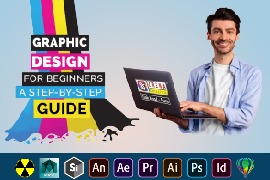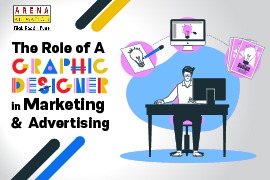Graphic design is a visual communication process that combines typography, photography, and illustrations to convey a message or solve a problem. The courses on graphic design for beginners can seem overwhelming for people willing to make their career in this field. Moreover, anyone can become a graphic designer with the right tools, techniques, and creativity.
This guide will provide a step-by-step introduction to graphic design basics, from choosing the right software to understanding design principles, color theory, and styles. With a solid foundation in these areas and a lot of practice, you can create visually appealing designs to communicate your ideas effectively.
Whether you’re pursuing a graphic design course or want to improve your skills, the guide will help you start your journey in graphics design.
Steps for graphic designing for beginners
- Step 1: Choose the Right Software
First, you must choose the right software for your purpose. The market offers a wide range of options, with the most prominent ones including Adobe Photoshop, Illustrator, and InDesign. Each program has pros and cons. So you can choose the best that suits your needs and expertise.
For instance, Photoshop is great for photo editing manipulation, while Illustrator is ideal for creating vector graphics and illustrations. InDesign is an excellent option for designing and laying out print materials, such as brochures and magazines.
But ensure to consider your design goals, budget, and experience when making a choice. Opt for free trials or demo versions to determine which software is best for you.
- Step 2: Learn the Basics of Design Theory
Before starting with graphic design, you must have a strong understanding of design theory. It includes learning the principles of balance, contrast, hierarchy, and proportion. These principles will guide your design requirements and help you create visually appealing designs. The balance is the visual weight distribution in a design, while the contrast refers to the difference between elements.
Hierarchy is the order of importance of elements in a design, while proportion refers to the relationship between the sizes of elements in a design. By mastering these design principles, you will be able to create designs that are not only aesthetically pleasing but also effectively communicate your message.
- Step 3: Familiarize Yourself with Color Theory
Color is crucial in graphic designing and can significantly impact the mood and effect of your designs. It’s essential to understand color theory, including how to use color to create contrast, choose appropriate color palettes, and evoke emotions to create compelling designs. That’s why, you must first study color wheel relationships and experiment with color combinations to find the right one for your designs.
- Step 4: Experiment with Different Design Styles
Graphic designing offers many different styles to help you experiment with minimalism, flat design, retro/vintage, and other popular styles. You can find the one per your purpose and design preferences.
It will help you develop a unique style and create your creative identity as a graphic designer. Do not fear to try new things and explore new techniques. Remember, the main goal is to have fun and find your creative voice.
- Step 5: Study the Work of Other Designers
The best way to improve your skills and get inspiration for your designs is to study the work of other designers. Look for designers whose work you admire and try to understand why their designs are practical.
Please take note of their use of color, typography, and composition, and try incorporating these elements into your work. It will help you develop your unique style and improve your design skills. Additionally, keeping an eye on current design trends and techniques will keep your skills up-to-date and relevant.
- Step 6: Practice, Practice, Practice
The key to becoming a skilled graphic designer is to practice with graphic design tutorials. Start by working on simple design projects and gradually increase the complexity of your designs as you gain confidence.
Try experimenting with different design styles and techniques, be bold, and step outside your comfort zone. Consistency is also essential – set aside some time each day or week to work on design projects. It will help you develop your skills and improve your eye for design.
It’s also helpful to have a portfolio of your work to showcase your abilities and progress. Start by creating a digital portfolio and consider printing a physical copy to showcase your work.
- Step 7: Get Feedback
Getting feedback on your designs is an essential part of the learning process and can help you improve your skills as a graphic designer. Share your work with others and ask for constructive criticism. It can come from friends, family, classmates, or online design communities.
Be open-minded and willing to learn from your mistakes. Try to understand the reasoning behind the feedback and use it to improve your designs. Remember that criticism can be hard to hear, but it’s an opportunity to grow as a designer. See feedback regularly, and don’t be afraid to ask for it. The more feedback you receive, the more you’ll be able to improve your skills and grow as a designer.
- Step 8: Stay Current with Design Trends
Staying current with design trends is essential to keep your skills sharp and your designs relevant.
- Follow design blogs: Many design blogs showcase the latest design trends and techniques. By reading these blogs, you’ll be able to stay up-to-date on the latest design trends and learn new techniques.
- Attend design conferences: Attending design conferences is a great way to learn from experienced designers, network with others in the industry, and stay up-to-date on the latest design trends.
- Participate in online design communities: There are many online communities where graphic designers share their work, provide feedback, and discuss design trends. Joining these communities is a great way to stay connected with others in the industry and stay up-to-date on the latest design trends.
Conclusion
Graphic design can initially seem intimidating, but you can become a graphic designer with suitable techniques and creativity. By following these steps, you’ll be on your way to becoming a successful graphic designer. Remember to practice, get feedback, and stay current with design trends, and you’ll be creating visually appealing designs in no time.




